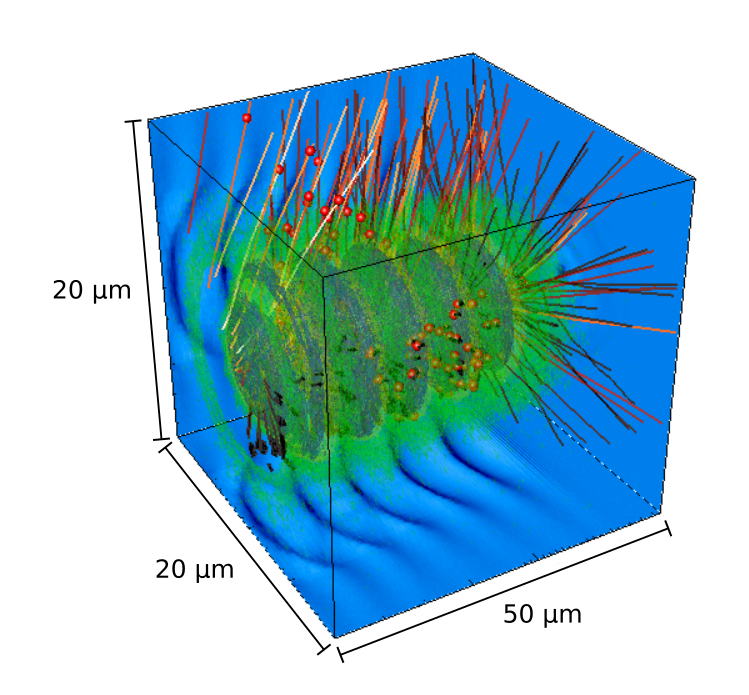High-power lasers can drive compact and cost-effective particle accelerators as a result of the large accelerating gradients achievable when using a plasma as the acceleration medium. A growing number of universities and research centers around the world routinely produce electron beams with energies from 10s of MeV to several GeV by focusing ultrashort laser pulses with power of tens or hundreds of terawatt into millimetre-scale gas or plasma targets. Laser-driven electron beams have an intrinsically short bunch duration, of the order of femtoseconds (10-15 s), and picocoulomb-level charge. During acceleration electrons can oscillate transversally in the plasma cavity, making laser-plasma accelerators also compact sources of X-ray radiation with 1-100 keV energy.

Electrons ejected at wide angles from the accelerating cavities trailing an intense laser pulse propagating in a plasma.
The same process leading to the formation of the accelerating cavity in a plasma also causes the emission of a high-charge electron beam in a large forward cone centred along the laser-propagation axis. Electrons are accelerated in lengths of about 10 µm by electric fields as large as 10-100 MV/m, resulting in the emission of a wide-angle beam with energy of about 1-2 MeV, nanocoulomb-level charge and sub-picosecond bunch duration. These high-charge, low-energy electron beams can be useful for applications such as non-destructive-testing, ultra-fast studies in condensed matter, radiolysis and radiotherapy. They can also be source of unwanted bremsstrahlung radiation if not properly dumped.
 .
.
Measured spatial profile of the wide-angle electron beam.
In a paper that has just been published in New Journal of Physics, X. Yang and co-authors present the results from simulation studies they have performed. These suggest that wide-angle electron beams can produce high-energy coherent terahertz (THz) radiation if passed through an interface between two media of different dielectric properties, such as a thin metallic foil or at the plasma-vacuum boundary of the accelerator.
Radiation in the THz band, which lies between the mid-infrared and microwaves, is of great interested because of the wide range of possible applications in areas such as imaging, spectroscopy, microscopy and communication. THz radiation is typically produced using optical rectification in electro-optic crystals or acceleration of photocarriers in semiconductor antennas, but these methods are limited by the damage threshold of optical materials, which typically restricts the maximum energy to sub-µJ levels.
Electrons passed through a perfectly conducting interface emit transition radiation in a forward hollow cone, as well as in the backward specular direction. Because of the sub-picosecond bunch duration, transition radiation produced by wide-angle electron beams is coherent in the 0.1-5 THz frequency range, and has energy from 10s of µJ to mJ levels, depending on the radiator size and position. Laser-plasma accelerators are currently limited by the laser repetition rate, which is typically 1-10 Hz. Commercial lasers with 100 Hz-1 kHz repetition rate are however expected to become available soon, making possible to produce THz radiation with an average power of 1 W, which is comparable with a far-infrared free-electron-laser.


